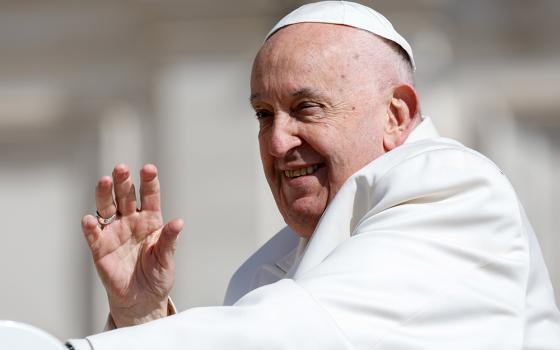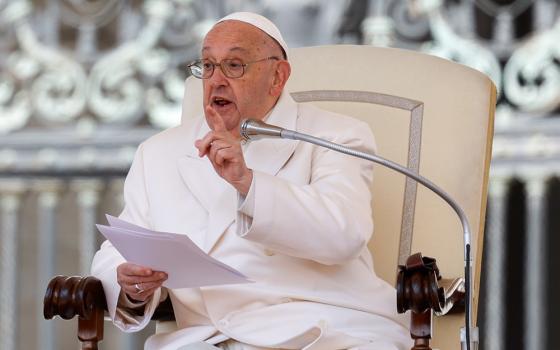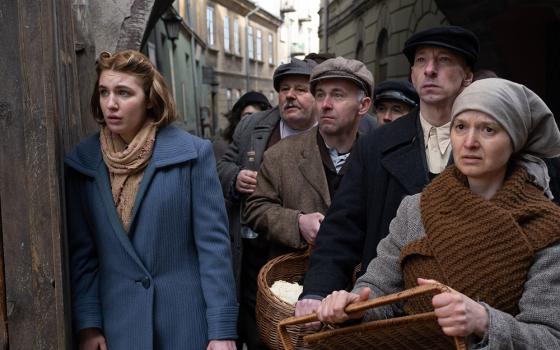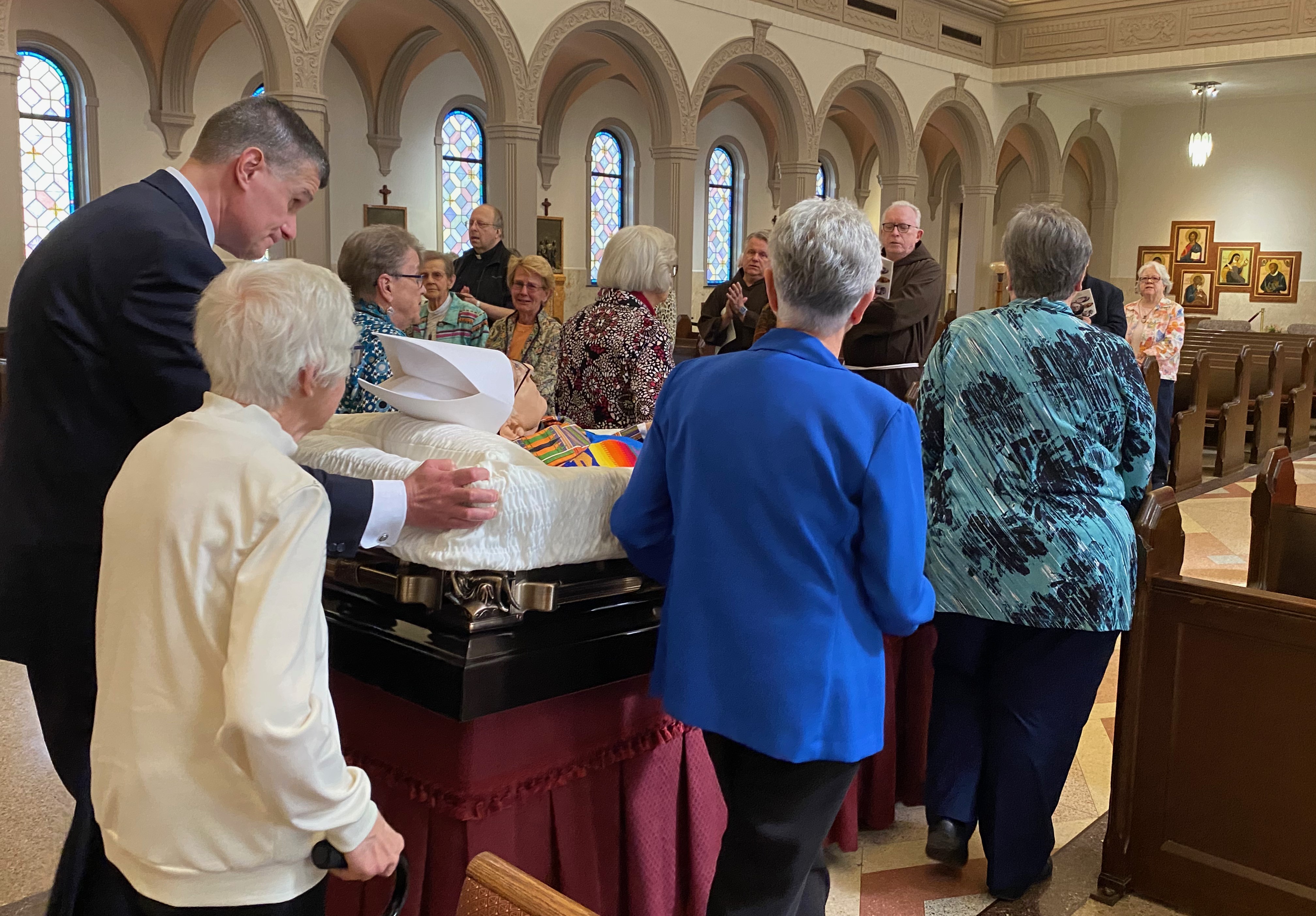
The Sisters of the Immaculate Heart of Mary's leadership team escorts Bishop Thomas Gumbleton's casket from their chapel April 10 during a memorial service at the congregation's motherhouse in Monroe, Michigan. They are followed by the bishop's sister, Sr. Irene Gumbleton, and his friend and funeral director Brian Joseph. (Christine Schenk)
Sr. Christine Schenk wanted to pay her respects to Bishop Thomas Gumbleton. She found a personal and heartfelt memorial service at the motherhouse of the Immaculate Heart of Mary Sisters in Monroe, Michigan.
On Wednesday April 10, I journeyed to the motherhouse of the Immaculate Heart of Mary Sisters in Monroe, Michigan, to bid goodbye to a deeply loved bishop, Tom Gumbleton.
Throughout my tenure at FutureChurch, when we were forbidden to host programs on Catholic property, Bishop Gumbleton not only spoke at one of our fundraisers but occasionally drove with friends from Detroit to attend our Cleveland events. In 2013, despite the Vatican investigation of U.S. sisters, he co-presided at a prayer service as we passed the FutureChurch torch to my gifted successor, Deborah Rose.
While other churchmen either kept their distance or actively attacked us, Bishop Thomas Gumbleton stood with us in the breach.
After his death on April 4, I knew I wanted to pay my respects. But I wasn't particularly looking forward to attending the elaborate funeral ceremonies that usually accompany a bishop's passing. An endless procession of male clerics — not to mention a dozen mitered men around the cathedral altar — were not my idea of how to say goodbye to this humble bishop who had "smelled like his sheep" long before Pope Francis ever came up with the phrase. Yet because I had loved and respected this bishop, I decided to grit my teeth and go.
But my plans quickly changed when I saw that the Sisters of the Immaculate Heart of Mary were hosting a wake and prayer service at their Monroe motherhouse. I needed a more personal, woman-friendly place to say my goodbyes. Plus, I would be glad for a sister-community within which to mourn and remember.
All afternoon long, scores of IHM sisters, sisters from other communities and male and female friends from near and far — including northern Michigan and Ohio — approached Tom's casket to pray, to remember and to give thanks for his graced life.
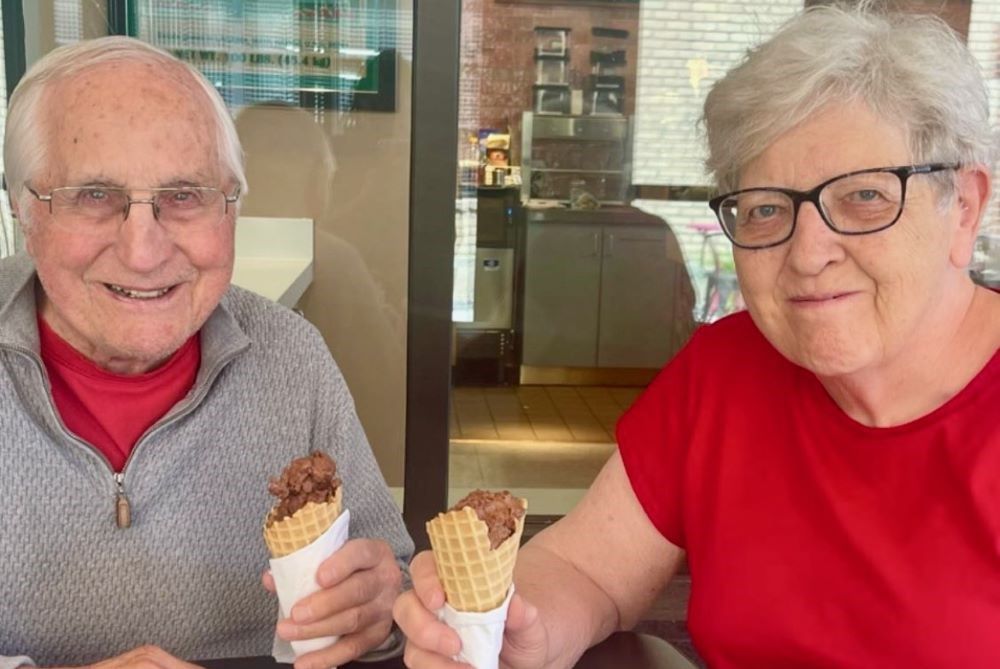
Bishop Thomas Gumbleton and Immaculate Heart of Mary Sr. Sue Sattler enjoy gelato, the bishop's favorite dessert. Gumbleton died April 4 at age 94. (Courtesy of Suzanne Sattler)
Sr. Jane Herb, president of the Sisters of the Immaculate Heart of Mary, opened the service by noting, "It is our honor to have Bishop Gumbleton come home to IHM. Tom embodied what IHM stands for. He was a man of deep faith, of courageous spirit and always acted for justice. As you know, IHMs are educators through and through. Tom was for us, and I'm sure for all of us, a masterful teacher in becoming doers of the word."
Created by Immaculate Heart of Mary Sr. Peggy Schmidt, the prayer service celebrated Gumbleton's lifelong commitment to living his episcopal motto "Be Doers of the Word." It was simple, contemplative and gently emphasized the wide-ranging — sometimes risky — actions this prophetic bishop took on behalf of peace and justice.
I wondered how this unique prayer and visitation had come to be. Over the next week I was privileged to interview not only Schmidt, but also Gumbleton's longtime friend and biographer Sr. Sue Sattler; his friend Brian Joseph, who had overseen all funeral arrangements; and his dearly loved sister, Irene Gumbleton, also an Immaculate Heart of Mary sister. The latter three accompanied the bishop during his final weeks, days and hours of life. Below I share an account of this graced time of accompaniment, some treasured memories and how this special IHM send-off came to be.
In the mid-1970s, Schmidt was appointed assistant vicar for parishes in the Archdiocese of Detroit, and had worked with Gumbleton for four years in his role as vicar for parishes. She remembers him as "a very good administrator" who valued mutuality with coworkers. As the only woman at monthly meetings of priest-vicars, she sometimes wondered if she should attend. "If you don't go, I don't go," her boss gently but firmly told her.
Schmidt soon recognized her boss's deep respect for people. She believes it is important to understand that "He wasn't a rebel. … But he was challenging the system for the sake of the poor and the downtrodden." Gumbleton invariably carried around a thick stack of pink phone messages. Between meetings he would return calls to those seeking his counsel. "He used to wear his collar all the time," Schmidt recalled. "And you know why? Because if anybody needed a priest, they'd know (he was available)."
Although she had been anxious about the short timeline, the experience of being asked to create Gumbleton's prayer service was "an absolute grace." With materials from Irene Gumbleton and Sattler, "It just came together. I didn't decide to make it all about peace, but peace and Tom were one so it turned out that way. And I know enough about the Spirit, [to know] it was really a gift of God."
The idea of having the sisters of the Immaculate Heart of Mary host the first public service for Gumbleton came from his longtime friend Brian Joseph, a funeral director who aided him during his decline. The owner of Detroit's Verheyden funeral homes, Joseph describes his mission as "always striving to celebrate the lives of people who made our community a better place to live … and that was Tom Gumbleton."
Joseph told Irene Gumbleton, "We are going to bring the bishop to the people. … He would go to the people, would he not? We don't need to have the people come to him … and it all starts at the IHM community." Joseph's team orchestrated a series of public funerary events throughout the archdiocese so people wouldn't have to travel far to say goodbye to their beloved bishop and friend.
With three paternal aunts and a sister in the IHM community, Gumbleton had been part of the IHM "family" from childhood. "We just grew up with the IHMs," remembers Irene Gumbleton. "And we went to IHM schools. So, basically our roots were with the IHM sisters. Tom had great respect for them and for his education with them."
Advertisement
Sattler recalled that Juliana Casey, IHM had worked with Gumbleton on the 1983 US bishops' pastoral letter on peace and that the community's legendary post-Vatican II president, Margaret Brennan, had once made him an "honorary IHM." For Sattler, "It was such a privilege and a blessing to have him among us as we would celebrate our own sisters."
Joseph was most moved by the service's five minutes of silence when people were asked to simply remember their bishop: "I'm in the back and looking at everyone. And you saw the Holy Spirit in the midst of everyone. Nobody moved. Everybody was in deep prayer. The visual gave the true sanctity," he recalls.
Sattler, Joseph and Irene Gumbleton had shared a difficult post-Easter week, watching their beloved friend slowly make his way to God. Gumbleton lived in a spartan studio apartment in southwest Detroit several doors from Sattler, who had known him and regularly prayed with him for many years alongside others in their small faith community. Sattler also worked with him on Central America justice issues and co-wrote his biography, No Guilty Bystander (Orbis 2023), with Frank Fromherz.
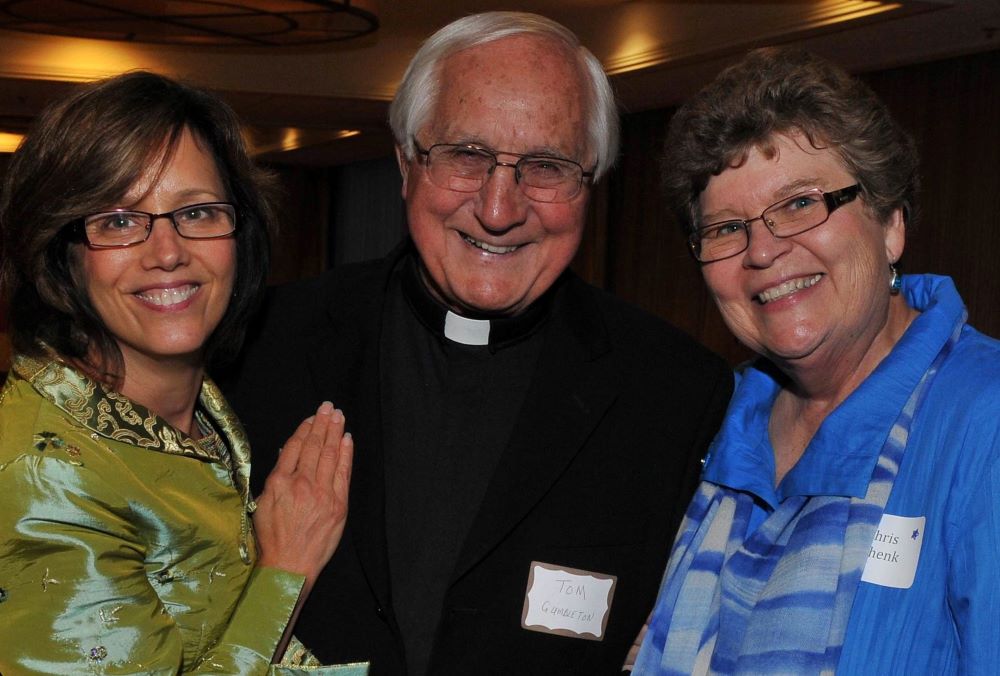
Bishop Thomas Gumbleton co-presides at prayer service for FutureChurch's leadership transition in 2013. The group's co-founder and outgoing executive director, Sr. Christine Schenk, is at right; the new director, Deb Rose-Milavec is at left. (Courtesy of FutureChurch)
After Gumbleton stopped driving, Sattler became his unofficial chauffeur and the two often shared an evening meal and/or some gelato. She describes her friend as "one of the freest people I ever met," who "prayed and consulted the Spirit" in making difficult decisions.
Like Irene Gumbleton and Joseph, Sattler was concerned about Gumbleton's increasingly frequent falls, but the trio decided to wait until after Easter to broach the idea of assisted living. Sattler called him each morning "I'd say, how are you?" she remembers. "And he would say, 'Excellent, I'm going to spend the morning letting God love me.' " Because Gumbleton was showing a significant decline in energy, his doctor sent him for tests and he was admitted to the hospital on Easter Wednesday.
That night his condition deteriorated dramatically. Irene and Sattler immediately went to his bedside. The next morning Joseph called a Capuchin priest friend to anoint the bishop. Sattler describes the moment as she, Irene and Joseph surrounded Gumbleton's bed with his nephew and power-of-attorney present via telephone from Peru:
It was so beautiful. Very peaceful. Father David had each of us say what we wanted to thank Tom for in our lives. Afterwards I leaned up and said, 'Tom, all we want is what you want' … and he pushed his arms out and nodded his head. It was so clear. And we said, 'We’ve got to let him go.' He communicated so clearly that he was already seeing the face of God. … And he died within the hour.
Irene Gumbleton is the last remaining of the nine Gumbleton siblings. Just 13 months older than Tom, she describes herself as an "Irish twin" to the brother with whom she played tennis and went cross-country skiing even into their senior years.
Asked what she wanted people to remember about her brother, Irene Gumbleton replied, "He stood up for what was right. … He was just very moral. And he practiced what the Gospel teachings were. And if we could all be that way, be doers of the Word and accept everybody and anybody and be inclusive in the church, we would be a much better church."






